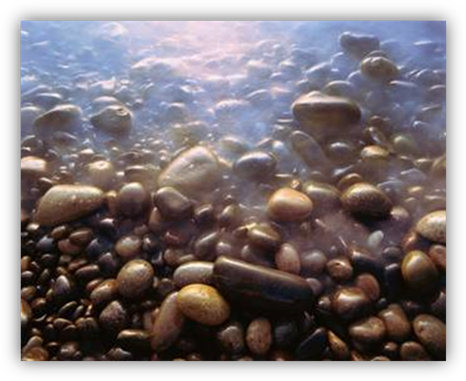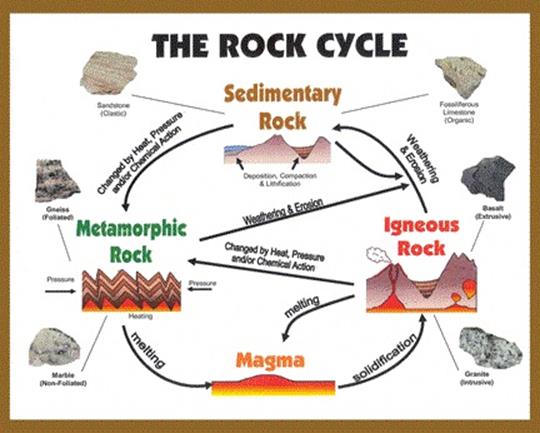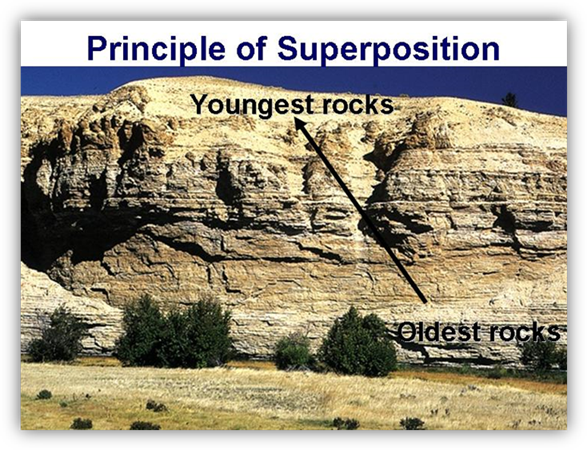

THE
ROCK CYCLE
Unit Overview
This unit investigates the processes that create the various types of rocks, and rock formations found on Earth. Different methods exist to determine the relative and absolute age of some rock layers in the geologic record. Key terms will be in bold.
GLOSSARY OF KEY TERMS
|
acid rain: any precipitation that has an unusually high concentration of sulfuric or
nitric acids resulting from chemical pollution of the air
|
erosion: process
by which rock and/or the products of weathering are removed
|
fossils: the
traces or remains of a plant or an animal found in sedimentary rock
|
igneous rock: any rock formed from cooled and hardened magma or lava
|
lithosphere: the thin outer shell of Earth, consisting of the crust and the
rigid upper mantle
|
magma: the
molten rock within Earth
|
mantle: the
layer of rock between Earth’s crust and its core
|
metamorphic rock: any rock formed from other rocks as a result of heat, pressure,
or chemical processes
|
mineral: a natural, inorganic solid with a definite chemical composition and a
characteristic internal structure
|
sedimentary rock: any rock formed from compressed or cemented deposits of sediment
|
weathering: the
change in the physical form or chemical composition of rock materials exposed
at Earth's surface
|
Study Suggestion: Make vocabulary cards to review the words for this unit. Try
putting the word on one card and the definition on another. Then play a
matching game!
|
Structure
and Origins of Rocks
·
All rocks are
composed of minerals.
·
Minerals are
natural, inorganic solids with definite chemical composition and internal
structure. EXAMPLE: Quartz (SiO2)
·
There are around
3500 known minerals in the Earth’s crust. Only about 20 of these minerals make
up 95% of all rocks.
Six most common rock-forming
minerals:
|
|
1.
Feldspar: Approximately 60% of the earth's crust is composed of feldspar. It is generally dull to opaque with a porcelain-like appearance. Color varies from red, pink, and white (orthoclase) to green, grey, and white (plagioclase). Feldspar is also hard but can be scratched by quartz. Feldspar in igneous rocks forms well-developed crystals roughly rectangular in shape, and they cleave or break along flat faces.
|
|
2.
Pyroxene: Green to black in color. Pyroxenite, an igneous rock composed totally of pyroxene minerals, is
related to ultramafic terrains and is therefore relatively rare at the
surface of the earth's crust.
|
|
3. Mica: Mica is easily
distinguished by its characteristic of peeling into many thin flat smooth
sheets or flakes. It is translucent to
black in color.
|
|
4.
Quartz: Quartz is a glassy-looking, transparent or translucent mineral that varies in color from white and grey to smoky. Individual crystals are generally clear, while in larger masses, quartz looks milky white. Quartz is hard, durable, and relatively inert.
|
|
5.
Amphibole: Amphibole is primarily black and forms long, slender crystals. Amphibolite is a metamorphic equivalent of basalt and can contain highly coarse-grained specimens of hornblende.
|
|
6. Olivine: Olivine is olive-green to black, translucent, with a conchoidal fracture. Olivine phenocrysts are relatively common in some basaltic rocks (like those found in Hawaii) and make a beautiful contrast with the black groundmass of the basalt. A semi-precious variety occurs (peridot), which can be cut and faceted like any other gemstone.
|
|
Other common rock-forming minerals
●
Calcite
●
Clays
●
Magnetite
●
Pyrite
●
Talc
Combinations of the rock-forming minerals result
in rocks with unique properties such as hardness, density, color, porosity, and
granular make-up. The appearance of a rock depends on the mineral make-up and
how the rock was formed.
Comparison
of Rock Texture
·
Rock textures and types depend on how the rocks were
formed.
Molten
Rock Cools to Form igneous rock.
·
As molten rock cools, the minerals in the rock form crystals. If the rock cools quickly, the crystals have less time to grow, and the rock will have a smooth texture. Obsidian is an example of this type. If the rock cools slowly, the crystals grow large, and the rock will have a granular, porous texture like granite.
·
Igneous rocks form from cooled and hardened lava or magma.
·
Igneous rock that cools on the Earth’s surface is called extrusive igneous rock. Basalt is the most common example of
this type.
·
Igneous rock that cools while trapped beneath the Earth’s surface is called intrusive igneous rock. Granite
is the most common form of this type.
·
The composition of magmais limited to the
eight common elements of the earth's crust. These elements combine within a
melt to form silicate minerals, the most common minerals of igneous rocks. These silicate minerals
include feldspars (plagioclase feldspar, potassium feldspar), quartz, micas
(muscovite, biotite), pyroxenes (augite), amphiboles (hornblende), and olivine.
These minerals make up over 95% of the volume of the common igneous rocks,
making igneous rocks easy to identify.
The photo to the right shows a volcanic (extrusive) igneous rock. Minerals that compose the rock are clearly much smaller, and many could be seen with a magnifying lens or microscope.
|
(Photo taken on beach at north edge of Lake Huron,
Ontario, Canada).
|
To show that not all igneous rocks are either plutonic or volcanic, the photo to the right shows one that exhibits characteristics of both. Large greenish crystals, called phenocrysts, are clearly visible. Much smaller crystals surround these crystals—the phenocrysts formed by slow cooling within a deeply buried magma chamber. Rapid eruption of the magma brought these crystals to the surface, where they were surrounded by magma that cooled rapidly during the eruption.
|
(Photo taken on beach at north edge of Lake Huron, Ontario,
Canada)
|
Sedimentary
Rocks
Examples of Sedimentary Rock
◦
Rocks made of pebbles and small bits of rocks
are called conglomerates.
|
|
The picture at the left shows a quartz-rich sandstone from a beach on the north edge of Lake Huron in Ontario, Canada. The image on the right shows a microscopic image of sandstone at varying magnification levels. On the left, the upper one-half of this boulder consists of well-sorted, small sand grains. The lower half consists of more poorly sorted pebbles and grains. The poorly sorted mixture in the lower half qualifies this part of the rock as a conglomerate, whereas the well-sorted character of the upper half qualifies it as a sandstone. .
|
|
◦
Rocks made of compressed sand are called
sandstone.
As the most common mineral in continental rocks, quartz sand grains are transported and deposited in numerous geologic settings. Two are shown below.
|
|
|
|
Great Sand Dunes National
Monument, Colorado. Geology by Light Plane Web site, courtesy of Dr.
Lou Maher.
|
Lower Wisconsin River. Geology by Light Plane Web site, courtesy of Dr. Lou
Maher.
|
Although sandstones frequently accumulate in horizontal layers, wind- and water-deposited sandstones often exhibit cross-bedding. Cross bedding preserves the tilted sides of dunes and sand ripples. Due to the migration of sand dunes and ripples, cross-bedded sandstones are distinctive and easily recognized. They are also excellent indicators of the local environment in ancient times (flowing water, beach, and desert).
|
|
|
|
Vermillion
Cliffs, Arizona, Photo credit– Thomas F. Osborne. |
|
◦
Rocks
formed from a highly compressed fine mud are called mudstone.
Mudstone is made up of tiny clay particles (less than 0.05mm) that can’t be seen with the naked eye. These tiny particles are deposited in quiet, low-energy environments like tidal flats, lakes, and the deep sea.
|
When mudstone is buried beneath
many layers of sediment deposited on top, it may be compressed to form shale,
which breaks easily into thin flakes.
|
|
|
Uses
of Mudstone: Pottery, bricks and cement
|
|
Metamorphic
Rock
|
|
Marble column formed from
Limestone
|
When mudstone or shale is heated
and pressured, it will form slate.
|
The Rock Cycle

Determining
the Age of Rocks
Assuming no change in the position of the rock
layers, the oldest will be on the bottom, and the youngest will be on the top.

Radioactive
Dating
The
Role of Thermal Energy